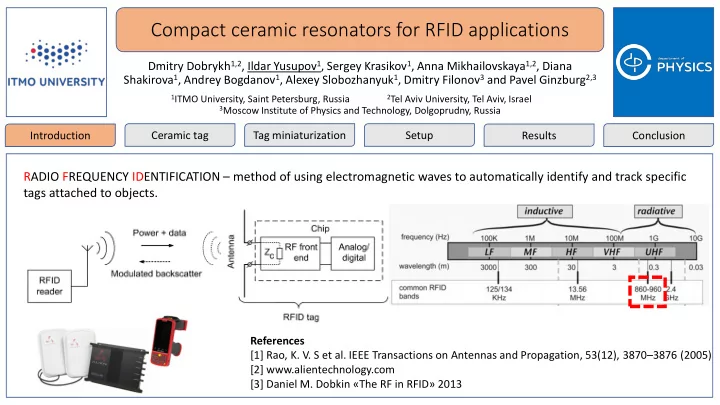

Compact ceramic resonators for RFID applications Dmitry Dobrykh 1,2 , Ildar Yusupov 1 , Sergey Krasikov 1 , Anna Mikhailovskaya 1,2 , Diana Shakirova 1 , Andrey Bogdanov 1 , Alexey Slobozhanyuk 1 , Dmitry Filonov 3 and Pavel Ginzburg 2,3 1 ITMO University, Saint Petersburg, Russia 2 Tel Aviv University, Tel Aviv, Israel 3 Moscow Institute of Physics and Technology, Dolgoprudny, Russia Introduction Ceramic tag Tag miniaturization Setup Results Conclusion RADIO FREQUENCY IDENTIFICATION – method of using electromagnetic waves to automatically identify and track specific tags attached to objects. RADIO FREQUENCY IDENTIFICATION – method of using electromagnetic waves to automatically identify and track specific tags attached to objects. References [1] Rao, K. V. S et al. IEEE Transactions on Antennas and Propagation, 53(12), 3870 – 3876 (2005) [2] www.alientechnology.com [3] Daniel M. Dobkin «The RF in RFID» 2013
Compact ceramic resonators for RFID applications Dmitry Dobrykh, Ildar Yusupov, Sergey Krasikov, Anna Mikhailovskaya, Diana Shakirova, Andrey Bogdanov, Alexey Slobozhanyuk, Dmitry Filonov and Pavel Ginzburg Introduction Ceramic tag Tag miniaturization Setup Results Conclusion Operational scheme of a miniature ceramic-based RFID tag Fundamental magnetic TE 010 mode |E| Radiation pattern: 1 0 𝐅 f = 900 MHz Displacement currents within high-Q resonator are inductively coupled to a metal split ring, functionalized with an RFID chip.
Compact ceramic resonators for RFID applications Dmitry Dobrykh, Ildar Yusupov, Sergey Krasikov, Anna Mikhailovskaya, Diana Shakirova, Andrey Bogdanov, Alexey Slobozhanyuk, Dmitry Filonov and Pavel Ginzburg Introduction Ceramic tag Tag miniaturization Setup Results Conclusion Comparison of miniaturization between metal tag and ceramic tag L =70 mm L =20 mm Metal dipole tag miniaturization by increasing the number of meandric elements (n): n = 4 n = 18 Ceramic tag miniaturization by increasing the Result: dielectric permittivity:
Compact ceramic resonators for RFID applications Dmitry Dobrykh, Ildar Yusupov, Sergey Krasikov, Anna Mikhailovskaya, Diana Shakirova, Andrey Bogdanov, Alexey Slobozhanyuk, Dmitry Filonov and Pavel Ginzburg Introduction Ceramic tag Tag miniaturization Setup Results Conclusion Impact of miniaturization of ceramic tags 2 𝑈𝐹 010 = 2.921 𝑑𝜁 −0.465 0.691 + 0.319 𝑆 ℎ − 0.035 𝑆 The resonant frequency of the fundamental magnetic TE 010 𝑔 (dipolar) mode in an open cylindrical resonator: 2𝜌𝑆 ℎ In all numerical simulations the same metal ring’s radius was used. Thus the matching conditions are not maintained and the current drops. The yellow star shows the value of the current, where the metal ring is also optimized. R chip =1650 Ohm C chip =1.12 pF
Compact ceramic resonators for RFID applications Dmitry Dobrykh, Ildar Yusupov, Sergey Krasikov, Anna Mikhailovskaya, Diana Shakirova, Andrey Bogdanov, Alexey Slobozhanyuk, Dmitry Filonov and Pavel Ginzburg Introduction Ceramic tag Tag miniaturization Setup Results Conclusion Electromagnetic properties of ceramic RFID tags Ceramic tags The numerically calculated S11 spectra Resonator R h ε of ceramic tags 1 19 mm 22 mm 80 2 17 mm 20 mm 100 Commercial tags Tag L h Proposed ceramic tags were 1 73 mm 21 mm experimentally compared 2 54 mm 34 mm with commercial RFID tags. 3 73 mm 23 mm 3 1 2
Compact ceramic resonators for RFID applications Dmitry Dobrykh, Ildar Yusupov, Sergey Krasikov, Anna Mikhailovskaya, Diana Shakirova, Andrey Bogdanov, Alexey Slobozhanyuk, Dmitry Filonov and Pavel Ginzburg Introduction Ceramic tag Tag miniaturization Setup Results Conclusion Evaluation of link budget of the system Parameter Physical meaning Value 𝑄 𝑢 Power transmitted by the reader 0.1 W (20 dBm) Two main limitations on reading distance: 𝐻 𝑈𝑆 Gain of the reader 8.5 dB transmitter/receiver antenna 1.22 dB ( ε =80) 𝐻 𝑢 Gain of the ceramic tag 1.61 dB ( ε =100) 𝑀 = 𝜇 𝑄 𝑢 𝐻 𝑈𝑆 𝐻 𝑢 𝜐 1.8 ∙ 10 −5 W (1) Chip sensitivity: 𝑄 𝑑ℎ Chip sensitivity 10 −8 W 4𝜌 𝑄 𝑑ℎ 𝑄 Reader sensitivity 𝑠 𝜇 Wavelength 0.33 m References 𝜐 Power transmission coefficient (CST) 0.65 ( ε =80) [5] Ref. 5 0.98 ( ε =100) 2 𝑁𝐹 4 𝑄 𝑢 𝐻 𝑢 2 𝐻 𝑈𝑆 𝑀 ′ = 𝜇 1.82 ( ε =80) ME Modulation efficiency Reader sensitivity: (2) 0.99 ( ε =100) 4𝜌 𝑄 𝑠 L Reading distance for equation (1) 5.19 m ( ε =80) 6.74 m ( ε =100) L’ Reading distance for equation (2) 6.42 m ( ε =80) References 5.75 m ( ε =100) [4] IEEE Transactions on Antennas and Propagation 53, 3870 (2005) [5] J.C. Bolomey et al. Proc. IEEE 98, 1555 (2010)):
Compact ceramic resonators for RFID applications Dmitry Dobrykh, Ildar Yusupov, Sergey Krasikov, Anna Mikhailovskaya, Diana Shakirova, Andrey Bogdanov, Alexey Slobozhanyuk, Dmitry Filonov and Pavel Ginzburg Introduction Ceramic tag Tag miniaturization Setup Results Conclusion Experimental demonstration of the reading range Yagi-Uda antenna (4 directors), with -15 dB matching in 880-960 MHz RFID reader KLM900 Micro USB SMA
Compact ceramic resonators for RFID applications Dmitry Dobrykh, Ildar Yusupov, Sergey Krasikov, Anna Mikhailovskaya, Diana Shakirova, Andrey Bogdanov, Alexey Slobozhanyuk, Dmitry Filonov and Pavel Ginzburg Introduction Ceramic tag Tag miniaturization Setup Results Conclusion Readout distance of ceramic tags and commercial tags Signal power, dBm 3 1 Commercial tags 4 5 2 Reading distance, cm Commercial tags Ceramic tags
Compact ceramic resonators for RFID applications Dmitry Dobrykh 1,2 , Ildar Yusupov 1 , Sergey Krasikov 1 , Anna Mikhailovskaya 1,2 , Diana Shakirova 1 , Andrey Bogdanov 1 , Alexey Slobozhanyuk 1 , Dmitry Filonov 3 and Pavel Ginzburg 2,3 1 ITMO University, Saint Petersburg, Russia 2 Tel Aviv University, Tel Aviv, Israel 3 Moscow Institute of Physics and Technology, Dolgoprudny, Russia Introduction Ceramic tag Tag miniaturization Setup Results Conclusion 1. The new type of RFID tags, based on ceramic resonators, has been investigated. 2. High permittivity ceramic (ε ~ 100) cylinder -based tags were shown to be detected from 25% larger distance in comparison to commercial tags. 3. The new architecture provides new routes for creating small-footprint RFID tags that support long reading range, which is valuable in numerous applications such as retail, security, IoT, and many others. Contacts: ildar.yusupov@metalab.ifmo.ru
Recommend
More recommend